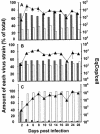Real-time PCR as a versatile tool for investigating the susceptibility of human herpesvirus 6 to antiviral agents
- PMID: 12937019
- PMCID: PMC182648
- DOI: 10.1128/AAC.47.9.3021-3024.2003
Real-time PCR as a versatile tool for investigating the susceptibility of human herpesvirus 6 to antiviral agents
Abstract
A quantitative real-time PCR assay was developed for the determination of antiviral drug susceptibility and growth kinetics of human herpesvirus 6. The susceptibility and fitness of a sensitive strain, HST, and its ganciclovir-resistant derivative, GCVR1, were then characterized, leading us to conclude that the mutations of this latter virus did not alter its fitness significantly.
Figures


Similar articles
-
Real-time PCR determination of human herpesvirus 6 antiviral drug susceptibility.J Virol Methods. 2007 Mar;140(1-2):25-31. doi: 10.1016/j.jviromet.2006.10.009. Epub 2006 Dec 6. J Virol Methods. 2007. PMID: 17156861
-
Susceptibility of human herpesvirus 6 to antiviral compounds by flow cytometry analysis.Cytometry. 2000 Jun 1;40(2):135-40. doi: 10.1002/(sici)1097-0320(20000601)40:2<135::aid-cyto7>3.0.co;2-h. Cytometry. 2000. PMID: 10805933
-
Human herpesvirus 6 ganciclovir-resistant strain with amino acid substitutions associated with the death of an allogeneic stem cell transplant recipient.J Clin Virol. 2009 Jan;44(1):15-9. doi: 10.1016/j.jcv.2008.09.002. Epub 2008 Oct 25. J Clin Virol. 2009. PMID: 18952495
-
Testing the susceptibility of human herpesviruses to antivirals.Future Microbiol. 2009 Nov;4(9):1111-23. doi: 10.2217/fmb.09.83. Future Microbiol. 2009. PMID: 19895215 Review.
-
[The human herpes virus type 6, the object of current research in the area of the herpesviridae].Rev Roum Virol. 1990 Jul-Dec;41(3-4):227-37. Rev Roum Virol. 1990. PMID: 1966010 Review. French. No abstract available.
Cited by
-
Reply to "Calibration technologies for correct determination of Epstein-Barr Virus, human herpesvirus 6 (HHV-6), and HHV-8 antiviral drug susceptibilities by use of real-time-PCR-based assays".J Clin Microbiol. 2013 Jun;51(6):2014. doi: 10.1128/JCM.00545-13. J Clin Microbiol. 2013. PMID: 23682103 Free PMC article. No abstract available.
-
Simultaneous quantification of Epstein-Barr virus, cytomegalovirus, and human herpesvirus 6 DNA in samples from transplant recipients by multiplex real-time PCR assay.J Clin Microbiol. 2007 May;45(5):1426-32. doi: 10.1128/JCM.01515-06. Epub 2007 Mar 21. J Clin Microbiol. 2007. PMID: 17376882 Free PMC article.
-
Evaluation of Epstein-Barr virus, human herpesvirus 6 (HHV-6), and HHV-8 antiviral drug susceptibilities by use of real-time-PCR-based assays.J Clin Microbiol. 2013 Apr;51(4):1244-6. doi: 10.1128/JCM.03234-12. Epub 2013 Jan 16. J Clin Microbiol. 2013. PMID: 23325820 Free PMC article.
-
Ether lipid ester derivatives of cidofovir inhibit polyomavirus BK replication in vitro.Antimicrob Agents Chemother. 2006 Apr;50(4):1564-6. doi: 10.1128/AAC.50.4.1564-1566.2006. Antimicrob Agents Chemother. 2006. PMID: 16569886 Free PMC article.
References
-
- Ablashi, D. V., H. B. Eastman, C. B. Owen, M. M. Roman, J. Friedman, J. B. Zabriskie, D. L. Peterson, G. R. Pearson, and J. E. Whitman. 2000. Frequent HHV-6 reactivation in multiple sclerosis (MS) and chronic fatigue syndrome (CFS) patients. J. Clin. Virol. 16:179-191. - PubMed
-
- Agut, H., H. Collandre, J. T. Aubin, D. Guetard, V. Favier, D. Ingrand, L. Montagnier, and J. M. Huraux. 1989. In vitro sensitivity of human herpesvirus-6 to antiviral drugs. Res. Virol. 140:219-228. - PubMed
-
- Boutolleau, D., C. Fernandez, E. Andre, B. M. Imbert-Marcille, N. Milpied, H. Agut, and A. Gautheret-Dejean. 2003. Human herpesvirus (HHV)-6 and HHV-7: two closely related viruses with different infection profiles in stem cell transplantation recipients. J. Infect. Dis. 187:179-186. - PubMed
Publication types
MeSH terms
Substances
LinkOut - more resources
Full Text Sources

